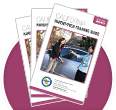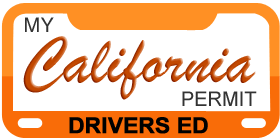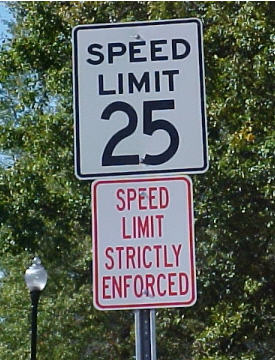Reducing speed allows more time to see details of the urban driving environment such as pedestrians, road hazards, and traffic flow. It also allows time to analyze what you see and predict what might happen, react to any hazards that might require quick reflexes, and execute decisions to safely change directions and avoid hazardous situations.
Many traffic violations involve speeding. Although there is no minimum speed limit in California, there is a law that requires you to not drive so slowly as to be unsafe.
You should reduce your speed when:
There are special speed limits you must follow even if there is no sign erected, including:
You should follow the same speed limit when passing school grounds when children are present, and when passing a senior center.
Sometimes lower speed limits are posted in the general vicinity of schools in addition to the school itself. Specially marked crosswalks and five-sided signs warns that you are approaching or are in the presence of a school.
NOTE: All 50 states have a basic speed law. In California, the Vehicle Code spells it out:
22350 - No person shall drive a vehicle upon a highway at a speed greater than is reasonable or prudent having due regard for weather, visibility, the traffic on, and the surface and width of, the highway, and in no event at a speed which endangers the safety of persons or property.
Red Means Stop!
Actually, red means that an action is forbidden (you don't "stop" at a red curb!), and whenever you see any red signal or road marking, it is up to you, as a responsible driver, to know what action is forbidden.
Although it seems simple enough, the definition of stop means all cessation of movement. The only way the examiner "knows" you made a complete stop on your drive test, is to feel the "inertia tug", where your body continues slightly forward when the car stops.
Without this tug, a "complete" stop was not made, and you will be marked off on your test for not making a full stop.
Stop
Stop laws are covered in the Vehicle Code, Sections 21453.
The YIELD sign, for example, doesn't mean stop. It means that you are forbidden from entering an intersection until you have yielded to all other traffic and pedestrians. You may need to stop, but not necessarily.
The STOP sign means that you are forbidden from entering an intersection until you have made a complete stop at one of three places:
The red on this sign indicates that you are forbidden to continue driving in this direction.
The flashing red light indicates one of two things: there may have been a power interruption and the intersection is treated as a four-way stop, or it indicates a dangerous intersection, and is used as an exclamation point to an already existing STOP sign. In any case, it means that you are forbidden to enter the intersection, until you first make a complete stop.
A red circle, with a diagonal slash, is the universal sign for a forbidden action.
A red curb means that stopping, standing, or parking here is forbidden . Even buses and emergency vehicles are forbidden from this area, unless a sign permits it, or if an emergency exists.
A red arrow means that travel, in the direction of the arrow, is forbidden. You may not make a right-turn-on-red against a RED arrow.
A solid red light means exactly the same thing as a STOP sign. Movement into the intersection is forbidden, until a complete stop has been made at one of the three locations. A right-turn-on-red may be made against a solid red light, but only after a complete stop has been made.
In any case, stopping is a required action whenever the traffic flow is dangerous enough to demand it.
Yield
If two vehicles enter an intersection from different directions at the same time and the intersection is controlled by stop signs in all directions or the signal light is not working, the driver on the right has the right of way. Otherwise, the driver who reaches the intersection first or is already in the intersection has the right of way.
Yield the right of way to emergency vehicles by pulling to the right when possible. If not possible to pull over, as in heavy traffic, pull as far to the right as traffic allows and stop your vehicle until the emergency vehicle has passed.
Right-of-way rules should be accompanied with common sense and courtesy.
Yield laws are universally accepted by all 50 states, based upon the National Uniform Vehicle Code. The purpose of any yield law is to clear a roadway or intersection as quickly and safely as possible.
These yield laws are likely to be on your permit test! Yield laws are covered in the Vehicle Code, Sections 21800 - 21806.
It is important to choose the least congested lane that is appropriate for what you intend to do next (turn, park, etc.).
When driving on roadways of two or more lanes of traffic moving in the same direction stay as close as possible to the middle of the lane. Change lanes only when there is sufficient space between vehicles to safely merge into traffic in the next lane by allowing at least a 4-second gap .
Never drive in the blind spot of another vehicle as they may not see you and change lanes into you. Change lanes one at a time keeping with the flow of traffic so as not to tie up traffic and cause an accident.
When changing lanes you should check blind spots by turning your head and looking in the lane you want to enter, using your rear-view mirror to check for vehicles directly behind you that may be starting to pass you, and checking the speed of persons ahead and behind in the lane you want to enter to be sure you have time and space to complete the lane change.
Although not illegal, it is not wise to change lanes in an intersection.
When changing lanes, or turning, or making any lateral movement of the car, use the SMOG technique:
Accelerate slightly as you change lanes. Remember, since you are moving sideways, you are moving slower than the rest of the traffic.
You should position your vehicle so as to:
Space to Cross or Enter
When crossing or entering city or highway traffic from a full stop, use your turn signal and leave a large enough gap to get up to the speed of other vehicles. You must share the space with traffic already on the road. It is important to know how much space you need for merging, crossing, entering, and exiting out of traffic. You need a gap that is about:
If you are crossing lanes or turning, make sure there are no vehicles or people blocking the path ahead or to the sides of your vehicle. You do not want to be caught in an intersection with traffic coming at you.
Even if the light is green, do not start across an intersection if there are cars blocking your way. It is against the law to enter an intersection unless there is space to get completely across. This situation is called gridlock .
This describes one of the major items that the DMV examiner will be watching for, while you are driving.
When turning left, do not start the turn just because an approaching vehicle has its right turn signal on. The driver may plan to turn just beyond you, or the signal may have been left on from an earlier turn. This is particularly true of motorcycles. Their signal lights often do not turn off automatically. Wait until the other driver actually starts to turn before you continue.
Follow another vehicle with about 3 seconds of distance to allow for safe stopping depending on speed and road conditions. Following too closely may result in:
Pay special attention when:
Maintain a 4 second gap in the above instances.
It is against the law to follow too closely given the traffic and road conditions. You could be cited for tailgating.
Be aware of drivers tailgating you and avoid them by:
Tapping your breaks in front of someone who is tailgating you, is illegal.
Intersections are common locations for collisions. On your drive test, you will be taken through 8 intersections where you will be evaluated on:
When approaching an intersection, it is important to determine as far ahead as possible whether the intersection you are approaching is controlled or not so that you can:
When entering "T" intersections, vehicles on the through road have the right of way.
The speed limit is 15 MPH at intersections if during the last 100 feet approaching the intersection, you cannot see the other roadways entering the intersection for a distance of at least 100 feet (blind intersection) and in alleyways.
You should signal during the last 100 feet before turning. On a freeway, you should signal for at least 5 seconds before exiting.
Use your turn signal any time you make a turn, including when:
If your signals don’t work, you must use hand signals. Use your signals even when you don't see other vehicles around.
Be sure your turn signal is turned off after you have completed your lane change so that you will not mislead other drivers.
When making a right- or left-hand turn:
To safely turn right, you should get close to the right edge of the road (watching for bicycles or motorcycles between your vehicle and the curb).
When making a left turn from a two-way street onto another two-way street, you should start from the leftmost lane. You may end in any lane traveling in the direction you are turning (unless otherwise controlled).
Unless otherwise prohibited by a sign, a U-turn is legal at an intersection:
When attempting a U-turn at an intersection:
Make U-turns from the leftmost lane at an intersection or divided highway where an opening has been provided.
Unless otherwise prohibited, you may make U-turns:
A U-turn is illegal:
You shall not park, stop, or leave your car standing:
You must use your turn signal when pulling next to and away from a curb.
You must never leave your car with the engine running or without setting the parking brake. When parked and leaving your vehicle, do not open your door on the traffic side unless you have determined it is safe to do so which includes looking for oncoming vehicle, bicycles, and motorcycles; leave the door open no longer than necessary to exit the vehicle.
Vehicles may be towed away if parked illegally and you will be responsible for towing and storage charges.
You must park within 18 inches of the curb and if there is no curb, you must be parked parallel to the side of the road. This is on your driving test!
Both wheels must be parallel to the curb, and within 18" of the curb.
The "emergency" or parking brake must be used whenever a vehicle is parked.
Safe passing requires:
At 55 mph, you will travel over 800 feet in 10 to 12 seconds, so will an oncoming vehicle. You will need over 1600 feet (or about one-third of a mile) to pass safely under these conditions. Since vehicles a distance of more than 1/3 of a mile seem to be heading toward you very slowly or even standing still it is difficult to judge how fast they are coming at you. If you can see the vehicle moving toward you, it is probably not safe to pass.
Do not pull out to pass until you know you have enough space to return. Before you return to the driving lane, be sure you are not dangerously close to the car you have passed. One way to do this is to look for the car in the rear-view mirror. When you can see both headlights, you have enough room to return to the driving lane. Do not count on having enough time to pass several cars at once. Do not count on other drivers making room for you.
On a two-lane highway a third lane may be made available for limited distances and for purposes of passing called a "passing lane." The passing lane is separated from the right-side lane by a broken white line. There will often be a double yellow line on the left side of the passing lane which separates you from oncoming traffic. You may not cross this line. A passing lane may be used only for passing, and you must return to the right lane as soon as you have completed passing. There will be signs indicating that a passing lane is ahead.
You should never drive off the paved or maintained portion of roadway to pass. The right edge of the main-traveled portion of the highway is marked by a solid white line. You may pass on the right as long as you do not leave the paved or main traveled portion of the roadway.
In general, you should pass a vehicle or bicycle going in your direction on the left and you should not drive closer than three feet to a bicycle when passing. If a lane is narrow, wait until traffic is clear so you can change lanes before passing a bicyclist.
You should never pass on the left or drive off road to the left when car ahead is signaling a left-hand turn.
The time saved by passing on two-lane roads is frequently not worth the risk.
Special regulations may be posted for passing:
In addition to not passing when signs prohibit it, it is particularly dangerous to pass when:
The adequacy of the space you have to pass must be judged in terms of:
It is dangerous to pass another vehicle in areas where there may be cross traffic such as near an intersection because your view and that of the driver crossing are both at least partially obstructed.
Assessing whether you can safely pass includes:
It is against the law to pass when your view of the road ahead is obstructed and when within 100 feet of a bridge, viaduct, or tunnel.
The steps for safe passing are to:
When passing, look ahead for changing lane conditions which may be signaled by:
When you are being passed by another vehicle, you should either:
Kaitlyn's Law
A parent, legal guardian, or other person responsible for a child who is six years of age or younger may not leave that child inside a motor vehicle without being subject to the supervision of a person who is 12 years of age or older, under either of the following circumstances:
Child Restraint Systems (Effective January 1, 2012)
The age limit for children who must be restrained in a child safety seat when riding in a motor vehicle has been raised. This new law prohibits a parent, legal guardian, or driver from transporting any child under eight years old in a motor vehicle without securing the child in an appropriate child passenger restraint system that meets applicable federal motor vehicle safety standards. A child under eight years of age who is 4 feet 9 inches in height or taller may be properly restrained by a safety belt rather than a child passenger restraint system. the new bill imposes fines and penalties for these violations.
The following California DMV videos provide excellent information on the rules of the road. These videos are not required for completion of this course; however, you may want to view them now or return to them later. You may proceed to the lesson quiz at any time.
These videos and other California DMV resources are also available on the California DMV YouTube channel.
You will now answer 5 questions to test what you learned during this lesson. You must answer all questions correctly to receive completion credit for this lesson. You may answer the questions as many times as necessary to get them right.
You should review the lesson material if you don't do well on the quiz.
 Download DMV Publications
California Parent-Teen Training Guide
California Driver Handbook & DMV Publications
Download DMV Publications
California Parent-Teen Training Guide
California Driver Handbook & DMV Publications
*Check with your California insurance agent for eligibility details. Every licensed California Driver must have auto insurance to drive a vehicle in California. Proof of insurance must be provided to the California DMV when you obtain your drivers license (not your learners permit).

